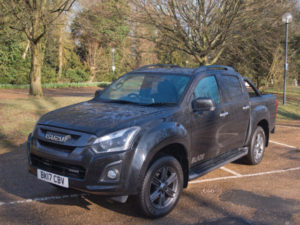A high specification and a small engine could be the ideal combination, says Dan Gilkes.

The pickup market continues to hold its own, at a time when overall van sales have peaked. There is little doubt that Benefit-in-Kind and VAT savings have helped to bolster popularity, but there also seems to be a genuine desire for dual-use trucks, driven in part by the rise in SUV and crossover sales.
While companies like Isuzu, Ford, Toyota, Nissan and Mitsubishi continue to offer real working pickups, with a variety of cab layouts and drivelines, the big sellers are the high-specification, high-powered range-toppers.
Isuzu updated its D-Max line last year and continues to keep a boot in both the working truck camp and the high-trim sector. Its range-topping Blade model certainly offers a comfortable driving experience, with a long list of standard specification including heated leather trim, climate control and a touchscreen monitor with sat nav and Bluetooth connectivity.
The D-Max Blade is offered in a simple choice of white or black, complete with a roller cover and styling bar or an Aeroklas canopy. The only options fitted to our truck were a towing hook and electrics, at just under £500.
The Blade trim also boasts the same driveline as the lesser models in the range, all of which dropped the previous generation’s 2.5-litre twin-turbo diesel engine, in favour of a new Euro 6, 1.9-litre single-turbo unit. While the power output remains a healthy 164bhp, the all-important torque peak has fallen slightly, from 400Nm to 360Nm.
On the road there is still plenty of performance, with easy motorway cruising and the ability to keep pace on cross-country routes. The D-Max Blade also makes a strong case for itself in town, where its relatively compact dimensions make it easy to thread through traffic and to park within defined bays.
Downsizing brings benefits in fuel consumption and emissions too, along with a drop in unladen weight. Admittedly the boost to the truck’s load-lugging ability is more noticeable in the lower-spec models, that aren’t carrying so many gadgets, but even the automatic transmission Blade has an extra 26kg of payload available, at 1,101kg. All D-Max models boast a 3.5-tonne towing capacity too, keeping them on a par with the competition.
Isuzu’s figures suggest up to 36.2mpg should be possible with the auto box, with CO2 emissions dropping from 220g/km to 205g/km. We saw an indicated 33mpg in daily use, falling to around 31mpg at higher motorway speeds. The 1.9-litre engine is fairly vocal though, particularly when cold or when called upon for rapid acceleration.
At launch, Isuzu was at pains to point out that this 1.9-litre engine is more than capable of keeping up with the previous 2.5-litre. But you suspect that many top-of-the-range buyers will no doubt still expect a more impressive motor beneath the bonnet.
The good news for fleets however, is that managers can now offer drivers the best of both worlds in a single package. The D-Max Blade is a high-specification pickup, without a bigger engine, retaining the improved emissions and fuel consumption of lesser models.
What we think
Downsizing has not damaged the performance of Isuzu’s D-Max, though it is perhaps a better fit lower down the trim ladder.
Specification
Model: Isuzu D-Max 1.9 Blade Auto
Basic price: £28,999
Engine: 4-cyl/1,898cc
Fuel injection: Common-rail
Power: 164bhp @ 3,600rpm
Torque: 360Nm @ 2,000-2,500rpm
GVW: 3,050kg
Kerb weight: 1,949kg
Payload: 1,101kg
Max trailer weight: 3,500kg
Load space length: 1,485kg
Load space width: 1,530mm
Load space height: 465mm
Width between wheelarches: 1,080mm
Combined CO2/MPG: 205g/km/36.2mpg
Fuel tank capacity: 76 litres
Oil Change: 2 year/12,000 miles
Warranty: 5 year/125,000 miles

